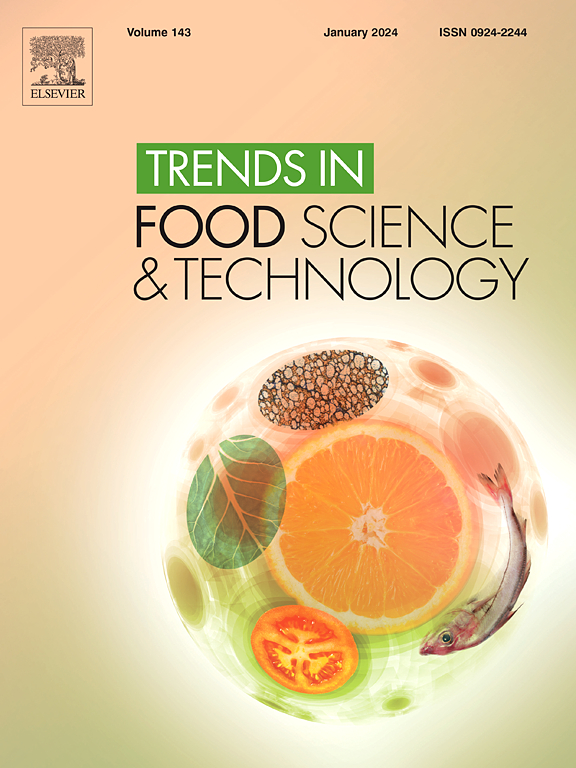Recent advancements in crop straw cellulose: Sustainable extraction, modification, and active film performance enhancement, and food preservation application
IF 15.1
1区 农林科学
Q1 FOOD SCIENCE & TECHNOLOGY
引用次数: 0
Abstract
Background
The rapid development of modern agriculture has highlighted the challenge of managing crop straw. Traditional incineration, while quick, causes significant air pollution. In the context of circular economy and sustainable development, high-value utilization of agricultural waste is crucial. Recent studies show that cellulose from straw has excellent film-forming properties and biodegradability, making it a viable alternative to petroleum-based plastic packaging. This reduces white pollution and creates economic value, offering a promising new pathway for utilizing straw waste.
Scope and approach
In this review, we outline technological pathways for transforming crop straw into functional packaging materials. Specifically, We evaluated the extraction effects of different extraction processes on cellulose from crop straw; explored the chemical modification methods of cellulose; studied the enhancing effect of cellulose on the performance of packaging films; and summarized the role of cellulose active packaging in food preservation, which was used for quality preservation and real-time freshness monitoring.
Key findings and conclusions
Cellulose in crop straw can be efficiently extracted by physical, chemical, and biological methods, and its properties can be enhanced by structural modification. Combined with innovative processing technologies, modified cellulose forms high-performance films/coatings that outperform conventional packaging materials in terms of mechanical strength, gas barrier efficiency, and multifunctional adaptability. However, straw cellulose still faces severe challenges in terms of technology, regulation, consumer acceptance and biodegradation, and a systematic solution is needed.
作物秸秆纤维素的最新进展:可持续提取、改性、活性膜性能增强和食品保鲜应用
现代农业的快速发展凸显了农作物秸秆管理的挑战。传统的焚烧虽然速度快,但会造成严重的空气污染。在循环经济和可持续发展的背景下,农业废弃物的高价值利用至关重要。最近的研究表明,来自秸秆的纤维素具有优异的成膜性能和生物降解性,使其成为石油基塑料包装的可行替代品。这减少了白色污染,创造了经济价值,为秸秆废弃物的利用提供了一条有前景的新途径。在这篇综述中,我们概述了将农作物秸秆转化为功能性包装材料的技术途径。具体而言,我们评估了不同提取工艺对农作物秸秆纤维素的提取效果;探讨了纤维素的化学改性方法;研究了纤维素对包装薄膜性能的增强作用;总结了纤维素活性包装在食品保鲜中的作用,用于食品品质保鲜和实时保鲜监测。结论农作物秸秆中的纤维素可通过物理、化学和生物三种方法高效提取,并可通过结构改性提高其性能。结合创新的加工技术,改性纤维素形成高性能薄膜/涂层,在机械强度、气体阻隔效率和多功能适应性方面优于传统包装材料。然而,秸秆纤维素在技术、监管、消费者接受度和生物降解等方面仍面临严峻挑战,需要系统的解决方案。
本文章由计算机程序翻译,如有差异,请以英文原文为准。
求助全文
约1分钟内获得全文
求助全文
来源期刊

Trends in Food Science & Technology
工程技术-食品科技
CiteScore
32.50
自引率
2.60%
发文量
322
审稿时长
37 days
期刊介绍:
Trends in Food Science & Technology is a prestigious international journal that specializes in peer-reviewed articles covering the latest advancements in technology, food science, and human nutrition. It serves as a bridge between specialized primary journals and general trade magazines, providing readable and scientifically rigorous reviews and commentaries on current research developments and their potential applications in the food industry.
Unlike traditional journals, Trends in Food Science & Technology does not publish original research papers. Instead, it focuses on critical and comprehensive reviews to offer valuable insights for professionals in the field. By bringing together cutting-edge research and industry applications, this journal plays a vital role in disseminating knowledge and facilitating advancements in the food science and technology sector.
 求助内容:
求助内容: 应助结果提醒方式:
应助结果提醒方式:


